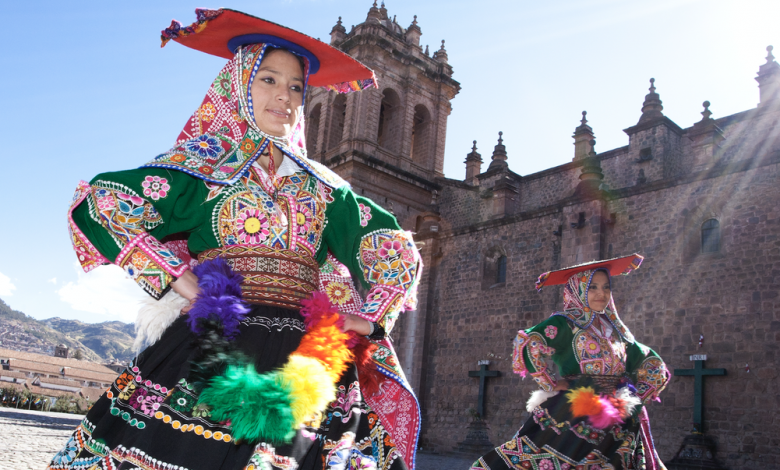15 Fun Hispanic Heritage Month Facts That Are Important to Know

[ad_1]
Hispanic Heritage Month has been celebrated in the U.S. for over 30 years. Formally known as National Hispanic Heritage Month, the annual event honors Hispanic cultures and traditions originating from 20 countries and one territory. Both the Hispanic and Latinx communities observe Hispanic Heritage Month because of their shared Spanish language.
Apart from understanding why the festivities happen between September 15 and October 15, there is a lot to discover about how Hispanics have been recognized by the country throughout history. If you’re ready to dive deep into fun Hispanic Heritage Month facts, keep on reading:
- Hispanic Heritage Month honors the contributions Hispanics have made to the United States. The celebration highlights “the histories [and] cultures … of American citizens whose ancestors came from Spain, Mexico, the Caribbean, and Central and South America,” according to the official website.
- Hispanic Heritage Month originally began as a week of celebration called National Hispanic Heritage Week in 1968, when President Lyndon B. Johnson signed the bill into law.
- There were two different attempts to make Hispanic Heritage Month happen. In 1987, Representative Esteban Torres of California tried to expand National Hispanic Heritage Week into a month-long occasion, which would “allow our nation to properly observe and coordinate events and activities to celebrate Hispanic culture and achievement.” Though it didn’t successfully pass Congress, Senator Paul Simon of Illinois later submitted a similar bill, and it was eventually signed by President Ronald Reagan on August 17, 1988.
- Hispanic Heritage Month is observed from September 15 to October 15 every year in the U.S. President George H.W. Bush first declared the 31-day period on September 14, 1989. As a congressman in the House of Representatives, he also supported the original bill proposed by Representative Esteban Torres of California.
- The start of the festive month on September 15 marks the Independence Day of Costa Rica, El Salvador, Guatemala, Honduras and Nicaragua. Then on September 16, Mexico celebrates its Independence Day, followed by Chile on September 18 and Belize on September 21.
- In the latter half of Hispanic Heritage Month, Mexicans observe the Día de la Raza (Race Day) on October 12, which was previously known as Columbus Day. Día de la Raza (Race Day) recognizes “the mixed indigenous and European heritage of Mexico.” What’s more, the end of the celebration (October 15) is only two weeks away from Mexico’s Dia de Muertos (Day of the Dead) on November 1 and November 2.
- In total, there are 20 Hispanic countries and one territory: Argentina, Bolivia, Chile, Colombia, Costa Rica, Cuba, Dominican Republic, Ecuador, El Salvador, Guatemala, Honduras, Mexico, Nicaragua, Panama, Paraguay, Peru, Puerto Rico, Spain, Uruguay and Venezuela.
- A person who identifies as Hispanic is from or has ancestors from a Spanish-speaking territory or country. The definition of Hispanic includes individuals from the aforementioned countries, plus Spain because Spanish is its official language.
- The term Hispanic was first recognized by the U.S. government in the 1970s after population data began to be collected, per the request of Mexican-American and Hispanic organizations. In 1976, the U.S. Congress passed a law for information about U.S. residents from Spanish-speaking countries to be officially recorded. Since then, Hispanic appears as an “ethnicity” in various forms for government, education and employment purposes.
- According to Pew Research Center findings in 2020, there are about 62.1 million Hispanics in the U.S., making up 19% of the total population. In a broader sense, over the past decade from 2010 to 2020, the U.S. population grew by about 23 million and Hispanics made up 51% of this increase.
- As of 2019, Mexicans comprised almost nearly 62% of Hispanics in the U.S., followed by Puerto Ricans and Cubans. The Pew Research Center reported in 2013 that 55% of the country’s Hispanic population lived in three states: California, Texas and Florida. This statistic remained true in 2020 findings with North Dakota and South Dakota experiencing the fastest growth in Hispanic populations.
- Apart from Hispanics celebrating Hispanic Heritage Month, the Latin community also has its own festivities. A person who identifies as Latino, Latina and/or Latinx is from Latin America or is of Latin American descent. The term Latino started appearing as an option on government documents in 1997.
- The word Latinx was first heard more than a decade ago, dating back to the 1990s. Pronounced “Latin-EX,” Latinx is a gender neutral alternative to Latino and Latina. It was created to show support to the LGBTQIA+ community for those who don’t identify as male or female. Despite Latinx being around for years, only 23% of Hispanics in the U.S. are familiar with the term and only 3% use it as an identifier.
- While Hispanic and Latinx people may have different histories and cultures, many are united through their shared language of Spanish. In 2021, Forbes stated that more than 559 million people speak Spanish around the world. Out of that number, 460 million people are native speakers, making it the second largest population of native speakers behind Mandarin.
- The U.S. doesn’t have an official language, but 13% of the population speak Spanish at home. According to Babbel, English takes the top spot as the most spoken language in the U.S. with 254 million speakers followed by 43 million Spanish speakers and nearly 3 million Chinese speakers. Forbes reports that one in three people will speak Spanish by 2050.
More on Hispanic Heritage Month
This content is created and maintained by a third party, and imported onto this page to help users provide their email addresses. You may be able to find more information about this and similar content at piano.io
[ad_2]
Source link






